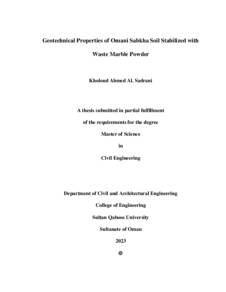وثيقة
Geotechnical properties of Omani sabkha soil stabilized with waste marble powder.
عناوين أخرى
الخصائص الجيوتقنية لتربة السبخة العمانية المثبتة بمسحوق الرخام
الناشر
Sultan Qaboos University.
ميلادي
2023
اللغة
الأنجليزية
الموضوع
الملخص الإنجليزي
The Arabic term "Sabkha" refers to salt-encrusted plains that lie beneath sand, silt or clay
soil. Sabkha is distributed in many areas in Oman, such as the coast of Batina, Ash
Sharqyah, Al Wusta and Ad Dhahirah, Umm Samim and Barr Al-Hikman. Owing to the
high salt content level of sabkha soil, geotechnical problems appear, including low shear
strength, primary and secondary settlement, corrosion, crystallized salt heaving, and flood
problems for low rates of infiltration.
This research aimes to investigate the use of marble waste powder for stabilizing Sabkha
soils. The samples of sabkha soil (SB) were collected from Al-Azaiba-Muscat, Sultanate
of Oman. An experimental program has been performed to identify the essential
characteristics of the collected soil, along with its physical, geotechnical, and chemical
properties. Soil samples were treated with cement (C) as a control binder and with cement marble waste (MPC) mix at ratios 0/100, 20/80 and 40/60%. Binders were supplemental
to the soil at proportions of 0, 2.5, 5, 7.5, and 10% by dry weight. In addition to physical
and chemical properties, unconfined compressive strength (UCS), California Bearing
Ratio (CBR) , Scanning Electron Microscope (SEM) , Energy Dispersive Spectroscopy
(EDS) , and X-Ray Fluorescence (XRF) were conducted for all treated samples.
The main findings indicate that the UCS and CBR of treated sabkha with 20% waste
marble powder is higher than sabkha treated with cement. This, due to the good properties
of cementitious materials and microfiller of waste marble powder.
In addition, According with the Unified Facilities Criteria (Department of Defense USA,
2004), the Federal Highway Administration (FHWA) (2013), the Mechanistic-Empirical
Pavement Design Guide (MEPDG, 2004), and the Indian Road Congress, New Delhi (IRC
37, 2012), sabkha treated by 5% of binder that contained 20% waste marble powder, could
be used as a subgrade course and subase layers. According to the Texas Department of
Transportation (2019) and the Portland Cement Association (1992), sabkha treated by 5%
of binder that contained 40% waste marble powder could be used for cement-treated sub base layer.
According to the Omani Highway Design Standard, all treated sabkha can be used for
embankment. Also, sabkha treated by 5% of binder that contained 40% and 20% waste
marble powder, treated sabkha with 7.5% of binder that contained 40% and 20% waste
marble powder and treated sabkha with 10% of binder that contained 40% and 20% waste
marble powder can be used for a drainage layers. Moreover, 5% of binder that contained
20% waste marble powder and 10% of binder that contained 40% and 20% waste marble
powder can be used for subbase.
المجموعة
URL المصدر
الملخص العربي
يشير المصطلح العربي "السبخة" إلى السهول المغطاة بالملح والتي تقع تحت الرمال أو الطمي أو التربة الطينية. تتوزع السبخة في مناطق عديدة في عمان مثل ساحل الباطنة والشرقية والوسطى والظاهرة وأم صميم وبر الحكمان. نظ ًرا الرتفاع مستوى المحتوى الملحي في تربة السبخة، تظهر مشاكل جيوتقنية متعددة، بما في ذلك انخفاض مقاومة القص، التسوية األولية والثانوية، التآكل، نفث الملح المتبلور، ومشاكل الفيضانات. يهدف هذا البحث إلى التحقق من استخدام مسحوق مخلفات الرخام لتثبيت تربة السبخة. جمعت عينات تربة السبخة من منطقة العذيبة - مسقط، سلطنة عمان. تم تنفيذ برنامج تجريبي لتحديد الخصائص األساسية للتربة المجمعة، إلى جانب خصائصها الفيزيائية والجيوتقنية والكيميائية. تمت معالجة عينات التربة باستخدام األسمنت (C (كعامل رابطة تحكم ومع خليط نفايات األسمنت والرخام (C-MP (بنسب 100/0 و 80/20 و .٪60/40 كانت الروابط مكملة للتربة بنسب 0 و 2.5 و 5 و 7.5 و ٪10 من الوزن الجاف. باإلضافة إلى الخواص الفيزيائية والكيميائية، تم إجراء مقاومة الضغط غير المحصور (UCS (، ونسبة تحمل كاليفورنيا (CBR (، ومجهر المسح اإللكتروني (SEM (، والتحليل الطيفي المشتت للطاقة (EDS (، وانحراف األشعة السينية (XRD (لجميع العينات المعالجة . تشير النتائج الرئيسية إلى أن UCSوCBR في السبخة المعالجة بنسبة ٪20 (80C20BSMP (كانت أعلى من مزيج التحكم نظ ًرا للخصائص الجيدة للمواد األسمنتية والحشو الدقيق ل MP. باإلضافة إلى ذلك ، يمكن استخدام مادة رابطة بنسبة ٪5 )60C40MP )كطبقة أساسية وطبقات قاعدة فرعية وفقًا لمعايير المرافق الموحدة )وزارة الدفاع بالواليات المتحدة األمريكية ، 2004( ، واإلدارة الفيدرالية للطرق السريعة )2013) (FHWA )، وغيرها. يمكن استخدام مادة رابطة بنسبة ٪5 )60C40MP )لطبقات القواعد الفرعية المعالجة باألسمنت. وفقًا لوزارة النقل في تكساس )2019(. وفقًا لمعيار تصميم الطرق العمانية )2017( ، يمكن استخدام جميع السبخة المعالجة للردميات. يمكن استخدام المجلدات التي تحتوي على ٪5 ) 60C40MP )و ٪5 )80C20MP )و ٪7.5 IX عالوة .الصرف لبطانيات( MP20C80( ٪10 و( MP40C60( ٪10 و( MP20C80( ٪7.5 و( MP40C60( على ذلك ، يمكن استخدام ٪5 )80C20MP )و ٪10 )60C40MP )و ٪10 )80C20MP )للقاعدة الفرعية.
قالب العنصر
الرسائل والأطروحات الجامعية

